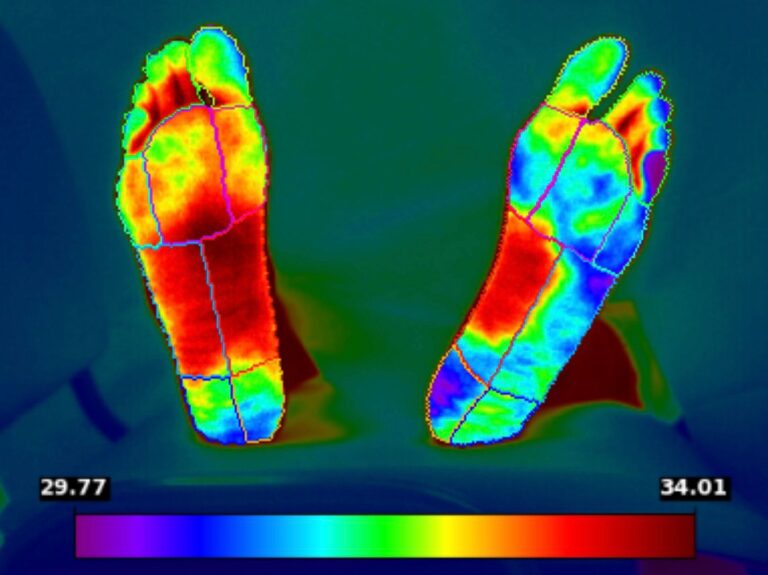
Diabetic foot ulcers are among the most severe and costly complications of diabetes mellitus. It is estimated that up to 34% of individuals with diabetes will develop a foot ulcer during their lifetime, and approximately 20% of those cases require hospitalization. These lesions not only increase the risk of amputation, but also have a significant negative impact on quality of life and place a heavy burden on healthcare systems.
Prevention and early diagnosis are essential to avoid serious complications. However, diabetic foot monitoring and care often present limitations in terms of objectivity, continuity, and predictive capacity. In this context, digital technologies are emerging as key tools to enhance wound management and improve clinical outcomes.
Risk Factors for Infection in Diabetic Foot Ulcers
Understanding the factors that predispose patients to infection is fundamental in designing effective preventive strategies. Below are some of the most relevant:
- Persistent hyperglycemia: Elevated blood glucose levels impair immune response and delay wound healing.
- Peripheral neuropathy: Loss of sensation prevents early detection of injuries or infection.
- Peripheral arterial disease (PAD): Poor blood perfusion limits the delivery of oxygen and nutrients required for tissue repair.
- History of previous ulcers: Existing or past lesions increase the likelihood of recurrence and infectious complications.
- Lack of proper clinical follow-up: Without regular check-ups, early signs of infection may go unnoticed.
Essential Clinical Measures to Prevent Infections
Implementing evidence-based clinical measures is critical to reduce the risk of infection in diabetic foot ulcers:
- Strict glycemic control: Maintaining appropriate blood glucose levels strengthens immune function and promotes healing.
- Proper hygiene and daily disinfection: Routine cleansing of ulcers reduces microbial load and lowers infection risk.
- Regular debridement: Removing necrotic tissue facilitates healing and minimizes bacterial colonization.
- Patient education and self-care: Training patients to recognize warning signs and adhere to daily care routines is essential for infection prevention.
The Importance of Technology in Early Prevention
Digital health technologies have become vital in improving the quality, continuity, and efficiency of clinical monitoring in diabetic foot care. Solutions like Clinicgram are revolutionizing traditional approaches by offering a platform that integrates artificial intelligence, thermal analysis, digital traceability, and real-time collaboration among care teams.
Through Clinicgram, healthcare teams benefit from:
- Structured and data-driven follow-up. The platform enables clinicians to record, organize, and visualize the evolution of diabetic foot ulcers over time, supporting proactive and longitudinal care.
- Remote access and decentralized care. Designed for use in both clinical and home settings, Clinicgram is especially valuable in rural areas, high-demand environments, or with patients who have limited mobility.
- Clinical decision-making support. Thanks to the integration of thermal imaging and AI-driven analysis, Clinicgram provides early alerts and visualizations of thermal asymmetries that may be missed in standard visual assessments.
- Improved communication among professionals. Clinical data and imagery can be easily shared between professionals, enhancing coordination between nursing, podiatry, endocrinology, and primary care teams.
How Clinicgram Helps Prevent Infections
Clinicgram acts as a strategic ally in the prevention of infections in diabetic foot ulcers, offering innovative solutions that support prevention, diagnosis, and continuous monitoring.
- Objective, contactless assessment.Infrared thermography enables the detection of temperature variations associated with inflammatory or infectious processes before they are visible to the human eye.
- Early alerts for thermal changes. AI-based algorithms within the platform identify abnormal thermal patterns and notify healthcare providers for timely clinical intervention.
- Digital monitoring and professional collaboration. The digital traceability of evaluations allows for streamlined communication and cooperation between specialists, improving both clinical decision-making and continuity of care.
Real-World Clinical Applications
The implementation of digital technology in diabetic foot management has proven effective across multiple care settings. Here are some examples:
- Home care: Remote monitoring tools allow patients to receive continuous follow-up without traveling to a clinic.
- Specialized hospital units: The integration of thermography and AI facilitates rapid and accurate lesion evaluation, optimizing resources and improving outcomes.
- Telemedicine: Digital platforms enable virtual consultations, reducing geographic barriers and improving access to expert care.
These use cases demonstrate the transformative potential of digital health in managing diabetic foot complications.

Conclusion and Key Recommendations
The integration of digital technologies into diabetic foot ulcer care marks a significant advance toward personalized and efficient healthcare. Tools such as thermal imaging, artificial intelligence, and remote monitoring platforms make it possible to detect complications in early stages, reduce the occurrence of severe lesions, and improve patient quality of life.
Clinicgram stands out as a strategic partner in this transformation, delivering cutting-edge solutions that support prevention, diagnosis, and long-term follow-up. By adopting such technologies, healthcare professionals can optimize clinical workflows and provide more effective, patient-centered care.Request more information and discover how Clinicgram can enhance your diabetic foot care strategy.
Please rate this post



